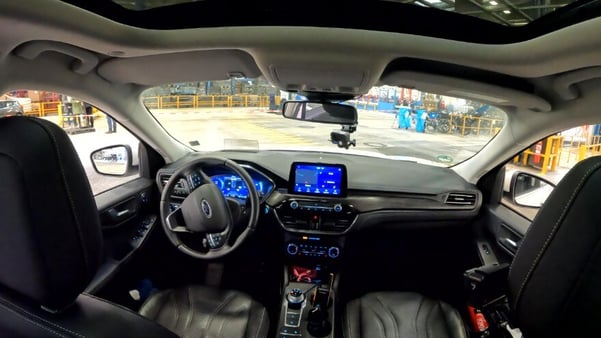Everywhere you look, technology is being used in new and creative ways to help develop solutions and make an impact. As participants in FIRST®, students are immersed in the world of STEM and robotics, developing the knowledge and skills needed to propel them into the evolving workforce. When considering where students could apply their FIRST-gained skills while having the opportunity to collaborate on some of the most innovative and groundbreaking robotics technology, one doesn’t need to look further than the work of FIRST sponsors. Keep reading to learn about the unique and innovative ways that FIRST Sponsors Aptiv, the Ford Motor Company, and TE Connectivity are changing the world through robotics.
Aptiv

Aptiv is a global technology company that designs, develops, and manufactures software and hardware solutions to enable a safer, greener, and more connected future of mobility.
At the core of Aptiv’s advanced driver assistance systems (ADAS) and automated driving (AD) technologies for vehicles, you’ll find no other than robotics technology. Using robotics, the company not only creates the sensing systems that enable the vehicle to understand its interior and surroundings, but also the software and hardware that processes the information from the sensing systems and determines the vehicle’s next action.
Outside of their ADAS and AD technologies, robotics are also critical to the fabrication and assembly of Aptiv’s hardware, and automation is used to make processes more efficient and flexible for the automakers. Robots are used in the shaping of their busbars (rigid wires responsible for transport of power in EVs) and in the picking and placing of components to assemble a control module.
Ford Motor Company

Ford Motor Company is researching robotics technologies that could enable non-autonomous vehicles to operate autonomously with the use of overhead sensing designed to remotely track and control vehicle motion.
To do this, infrastructure sensors such as LiDARs and cameras would be used to detect the vehicles’ positions and hazards around them, while software in the system would perform tasks such as path planning and fleet management. Leveraging advances in wireless connectivity that ensure swift and reliable communication, this technology would allow vehicles within manufacturing plants, defined public parking spaces and logistics centers, among other environments, to navigate autonomously.
Vehicles equipped with this technology could initiate ignition, change gears, and navigate, all without human intervention. Currently under trial, this innovative project showcasing infrastructure-based versus vehicle-based sensing represents a unique opportunity for the application of robotics and automation.
TE Connectivity
At TE Connectivity, robotics have been an extremely important part of manufacturing for years, keeping human factory workers away from dangerous machinery and handling repetitive motions, which can lead to physical strain or injury.
As next-generation factories are realized through the Industrial Internet of Things, industrial robots and cobots (collaborative robots that work alongside their human counterparts) are taking an even bigger responsibility. What’s different about this new generation of machinery is that it all needs to communicate with one another, and that’s accomplished through connectors, sensors, cables, and more developed and manufactured by TE Connectivity.
In the traditional assembly line factory designed by Henry Ford, one process happens after the other in the same order, resulting in the end product. This isn’t necessarily true with newer factories, where products that need to be customized will move throughout the factory via various paths, with the assistance of automated guided vehicles. The process may seem chaotic from an outsider’s perspective, but it’s all a well-choreographed dance enabled through TE technology that allows these moving parts to communicate and work together.
To learn more about the evolution of the factory, read this TE Perspectives article.
